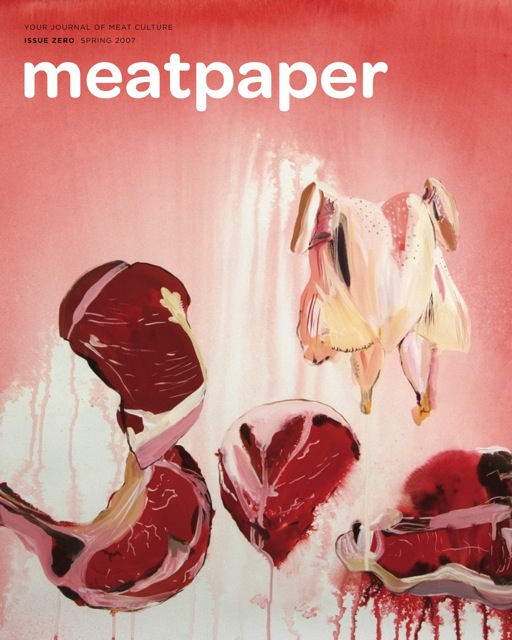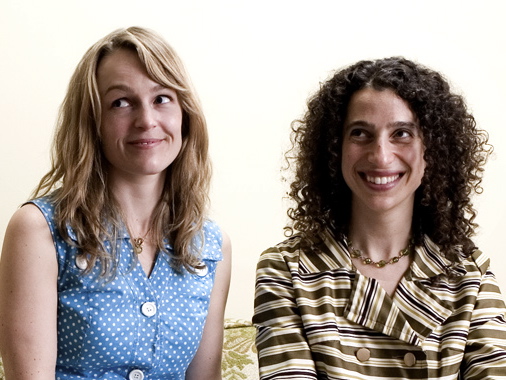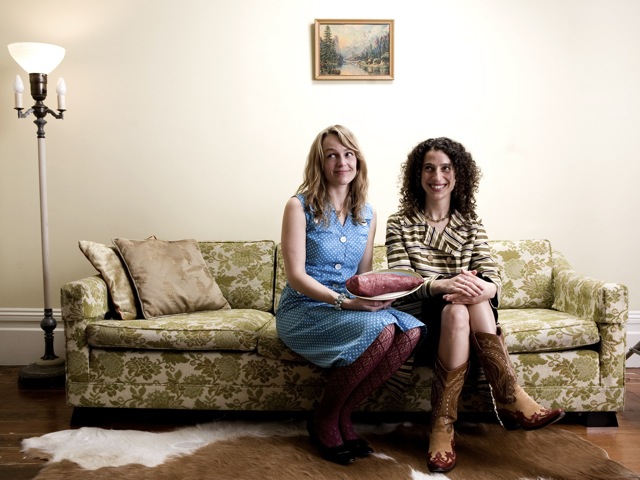
magcover, l
(article, Twilight Greenaway)
[%pageBreakSettings nobreak=true] p(blue). Sasha Wizansky and Amy Standen are the team behind Meatpaper, a new art-and-culture magazine designed to look at meat “as a growing cultural symbol and phenomenon.” p(blue). Wizansky, a visual artist/graphic designer, conceived of the magazine two years ago; she began working with Standen, a friend and colleague from her Salon days, on the project a year ago. The first issue of Meatpaper was published in March. What has been the initial response to Meatpaper? Standen: We both found that whatever kind of meat story people wanted to see, they found in us. Wizansky: When we tell them it’s a magazine about meat, they assume that we’re either militant vegans or that we’re on a pro-meat soap box, but we’re not either. [%image couch float=right width=400 caption="Amy Standen (left) and Sasha Wizansky are the founders of the magazine Meatpaper." credit="Photo: Julio Duffoo"] In a way, that really gets at people’s passionate feelings about meat. Wizansky: Exactly, which is why we wanted to start the project in the first place. Standen: It’s a really loaded topic. I got to go to dinner at Chez Panisse recently and I had the magazine with me. I was given a tour of the kitchen and met the chef and I handed him a copy of the magazine. He turned to the graphic photo essay in the back, of a pig slaughter in Italy, and he was horrified. He didn’t read it, so he didn’t really know what to think, but he had an instant protective feeling, like this was sort of an exploitation of what he did. But actually, those photographs are an homage to traditional meat preparation in this tiny town in Italy. On the other hand, there are people who see those photos and they think that we’re doing this shameless anti-vegan treatise. But then there’s sort of a middle ground between the two camps, which I saw come out when we interviewed Chris Cosentino, who is the chef at Incanto. He took his whole staff to a goat slaughter, and everyone — even the waiters — went and watched this, and they left feeling really moved by it, and not necessarily in good ways. His whole thing was that you might see a slaughter and decide that you never want to eat meat again, and that would be a totally rational response. Or you might see it and say, “Well, if we’re going to eat animals, we should eat every single part and prepare them respectfully.” In so far as we have a position on anything, which we really don’t, we do appreciate that approach. Wizansky: But some of this has nothing to do with eating meat or not eating meat. Meatpaper is about how meat has been absorbed into the cultural imagination. And it’s not necessarily about restaurants. And we think people’s choice not to eat meat is a big part of the story of meat in our culture. It’s all a reaction to meat; even being a vegetarian is a reaction. One of the things that we’re hoping to do is more anthropological stories. We have the sense that learning about a culture’s relationship to meat will tell you a lot about that culture. In one article in your first issue, a theorist draws a connection between meat and today’s city. Can you say more about that? Wizansky: Yes, he talks a lot about how the language of meat is used to describe the urban landscape, like the arteries, the tenderloin, etc. Standen: He says we now talk about green belts rather than arteries, because we want to think of ourselves as a leafy green culture, not a meat culture. Do you think there’s been an attempt to obscure certain things about meat? Standen: It’s almost a cliché to say at this point, but for a long time meat was something we all got from Safeway wrapped in cellophane. At the same time we love animals. So there’s this cognitive dissonance between our love for animals and our love for meat, and we require that there be a certain gulf between the two. When Sasha and I first talked about the project, I was living in Slovenia, where horse is a really common, totally acceptable, traditional thing to eat. And not just for poor people; it’s actually the food the new affluent class wants to eat. So I ate horse carpaccio and horse steak, and that got me thinking about what is and is not allowed to be “meat.” Do you think there’s a connection between our attitudes to animals and meat, and the way that people used to take care of and spend time with the bodies of their family members when they passed away? Standen: Yes, it’s a really carefully preserved failure to understand something. We can’t really get too comfortable with ourselves as flesh. Maybe the fear of meat relates to mortality, in general. Wizansky: Curiously, one of the reasons we’re doing this project now is because we really appreciate that a lot of that fear and taboo about meat has been going away. And people are really embracing meat in the last five to 10 years in a way that they didn’t in the previous decades. People are looking back to more traditional cultures and different times for inspiration and also seizing on the idea of meat as something really exciting. Meat is everywhere; there’s a bacon-of-the-month club, and there are all kinds of products now with meat-related imagery on their labels. [%image magcover float=left width=300 caption="The cover of the debut issue of Meatpaper magazine." credit="Photo courtesy Meatpaper"] Standen: Yeah, there’s this kind of fascination. It’s almost like you have to sort of confront it, be repelled by it, and then embrace it all over again. And I mean really embrace it, go crazy, there are like nine new charcuteries popping up here and all these macho chefs doing the Slow Food thing, so it’s coming full circle, in a way. Do you think we’re in post-vegetarian times? Do you know a lot of people who have been vegetarians who no longer are? Wizansky: I feel like that’s very true in my particular community. And I’d like to know if it’s a coastal phenomenon. But maybe we were the ones who were vegetarians to begin with. I even went to a dinner party recently which was designed to get my friend to learn to love bacon. And it worked! The chef wrapped dates in thick-cut bacon and grilled it on an outdoor grill and she loved it. Standen: Bacon is a gateway meat. I don’t know why; in a way it’s one of the most extreme forms of it. But I’ve met many people who say they’re vegetarian, except for bacon. Wizansky: There were times in my vegetarianism when I was a lacto-ovo-pesca-prosciutto-tarian. Is Meatpaper just a flash in the frying pan? Wizansky: A lot of people have asked us, when they hear about this magazine, “How are you going to have enough to say about meat?” We have the opposite problem. It’s really hard to hone in; there are so many ways to examine the topic of meat. It could really be a lifetime process. p(bio). Twilight Greenaway is a writer and editor living in the Bay Area. She has recently begun eating some meat, after years of vegetarianism, but has not yet given in to the power of bacon.

magcover, l

reference-image, l

couch, l